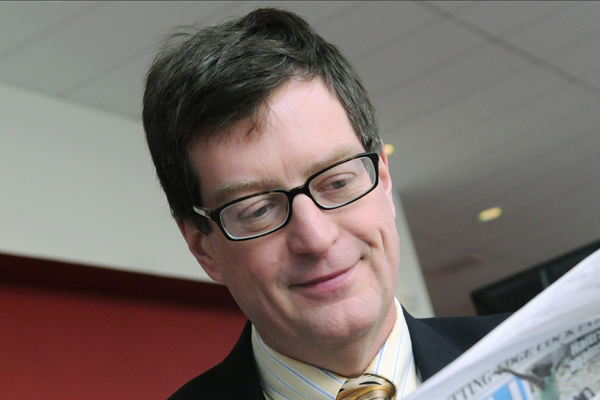3Qs: Rolling Stone’s controversial cover

Earlier this week, Rolling Stone unveiled the cover of its August issue: a glam photo of Boston Marathon bombing suspect Dzhokhar Tsarnaev. Many readers—particularly those from the Boston area—were outraged, saying the cover treatment turned an alleged murderer into a rock star. Several retailers and organizations, including Northeastern, have pulled the controversial issue from their stores. We asked Dan Kennedy, an assistant professor of journalism in the College of Arts, Media, and Design, to explain Rolling Stone’s decision and how the public’s perception of the magazine has shaped the outrage.
Was it sound journalism for Rolling Stone to place a glam photo of Tsarnaev on the cover of its magazine?
Yes, it was. I thought it was quite an effective cover because of the cognitive dissonance it evoked. We see Dzhokhar Tsarnaev looking like a teen idol, yet the headline refers to him as “the bomber” and “a monster.” We also know that this is who Tsarnaev was—or who his friends thought he was—before he began his descent into terrorism.
I didn’t see the cover as glamorizing him at all. Rather, I saw it as an attempt to explain how a seemingly normal teenager became “a monster” accused of carrying out the worst terrorist attack in the United States since 9/11. I think one of the main reasons that people are so disconcerted is that he doesn’t look like a terrorist—rather, he looks like he could be their own child.
My only reservation is that the cover could serve as an inspiration to other alienated kids who might decide to turn their own violent fantasies into reality. But though journalists have an obligation to act responsibly, they shouldn’t ground their editorial judgment in what effect their decisions might have on budding sociopaths.
The saying goes that pictures are worth 1,000 words. Will people who say Rolling Stone turned an accused killer into a rock star based on its cover treatment change their minds by reading the article? Or does the photo simply hold too much power?
I’m not sure that Rolling Stone’s critics are inclined to change their minds at this point. The article, by Janet Reitman, is quite good. There’s not much new information, but she offers a lot of details about Tsarnaev’s alienation from his family and his gradual embrace of radical Islam. I’ve seen some people accuse Reitman of offering excuses for Tsarnaev, but that wasn’t how I read her story. To explain is not to excuse. We need to understand as best we can what happened and why. The article helps us do that.
How might the immediate reaction of the photo of Tsarnaev been different had Time, or another well-established news magazine, used the image?
On May 5, The New York Times ran exactly the same image on page one, three columns wide, above the fold. Even the article was roughly the same: an attempt to explain why and how Tsarnaev embraced terrorism. But it didn’t provoke any outrage. I imagine it’s because people perceive the Times as a serious news source and Rolling Stone as a fluffy repository of gossip about entertainers and celebrities.
Yet Rolling Stone has always included serious news and those stories sometimes find their way onto the cover. In 1970, for instance, the magazine ran a large cover image of Charles Manson that—if not exactly flattering—nevertheless portrayed him in a more favorable light than we’re used to seeing. The headline called Manson “the most dangerous man alive,” foreshadowing the juxtaposition of the image and headline we see with Tsarnaev. Time, of course, is well-known for running full-cover images of villains, including Joseph Stalin, Osama bin Laden, and Adolf Hitler, its “Man of the Year” in 1938. And Time has received some criticism for those covers. But there’s no question that Time received the benefit of the doubt because of its reception as a serious news magazine in a way that Rolling Stone has not.




